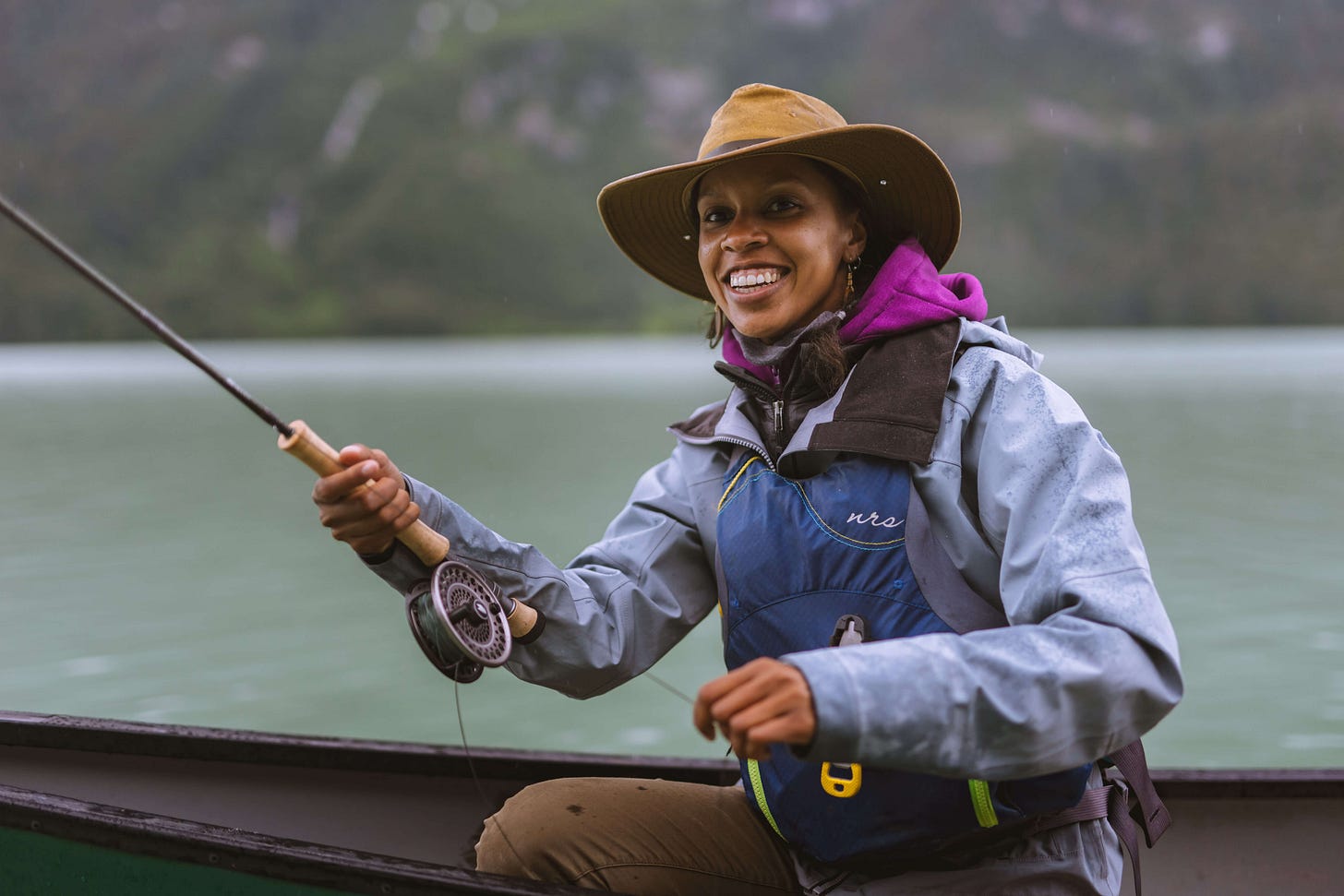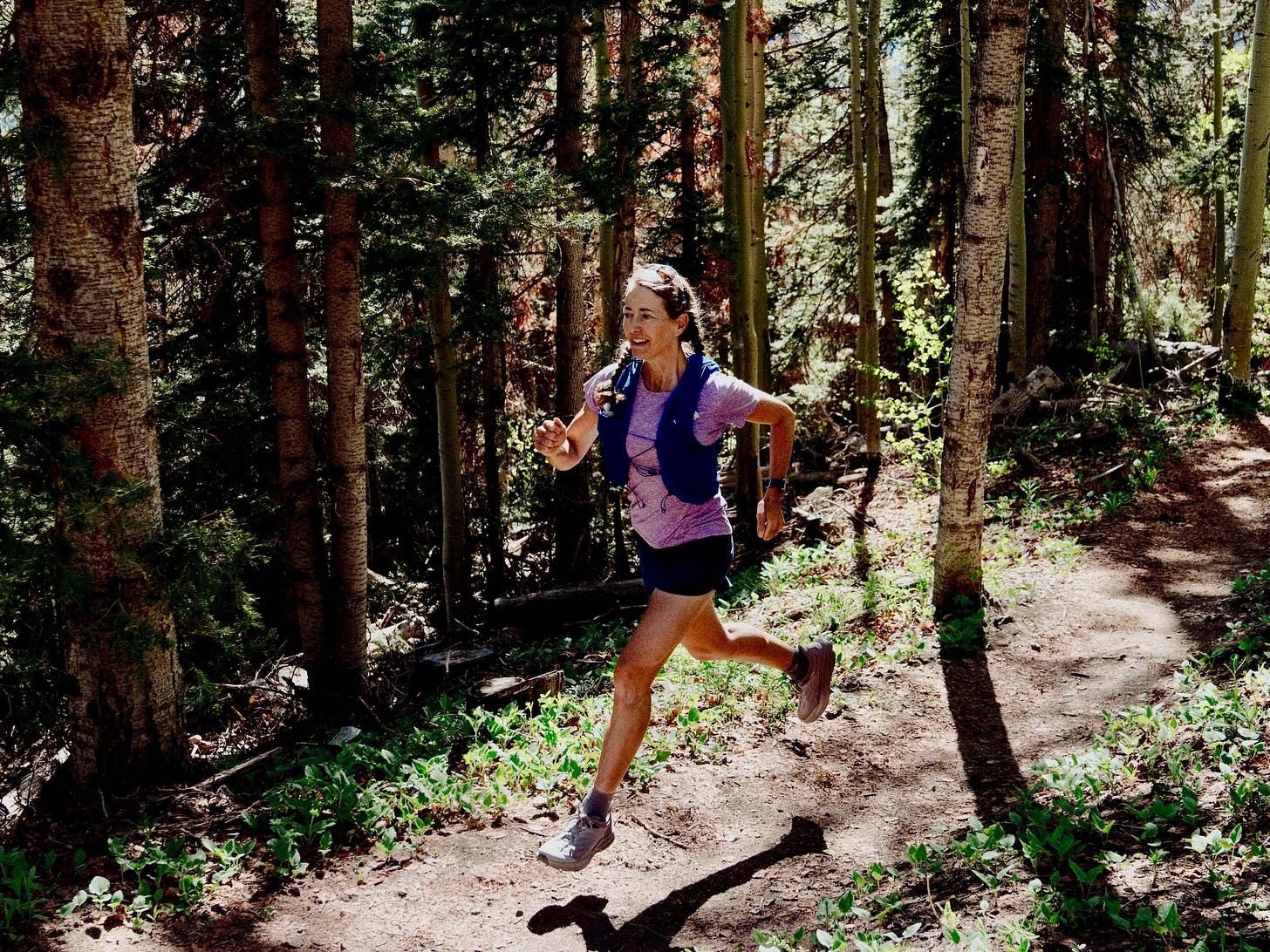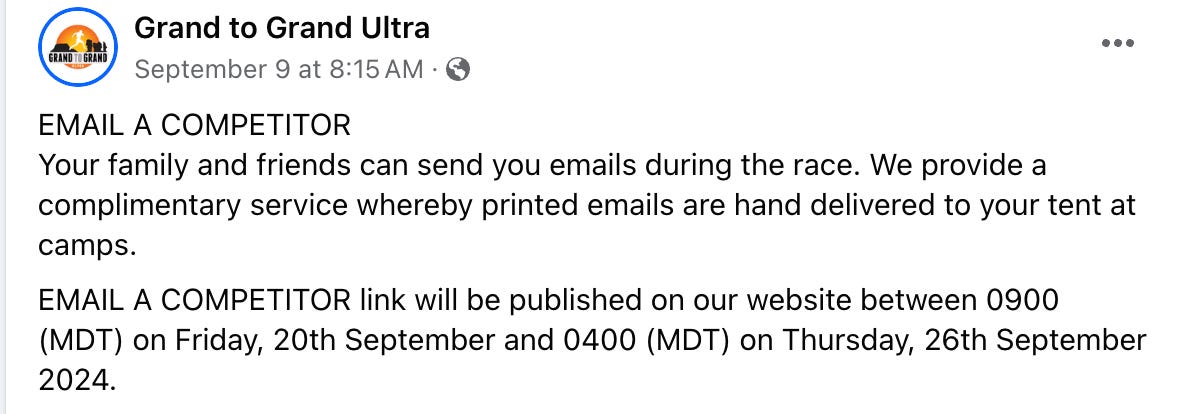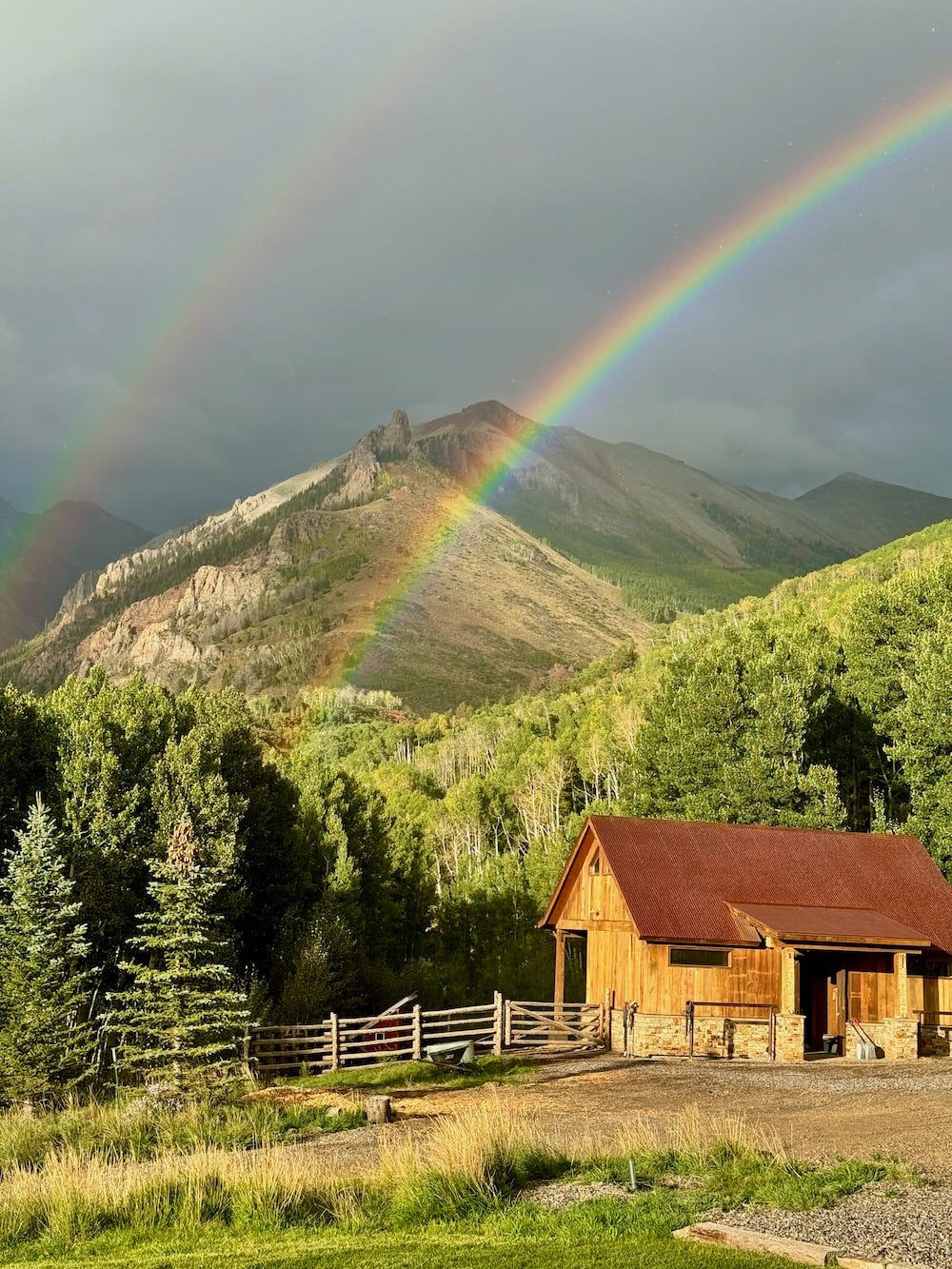Later today—Wednesday, September 28, 5pm Mountain—I’ll host the monthly online chat for paid subscribers. If you’d like an invitation to this Zoom and occasional bonus posts, please consider upgrading your subscription to the supporter level.
Get “spring” in your step
The other day, a promo email from Aravaipa Running landed in my inbox with encouragement to register for one of my favorite April ultras, Whiskey Basin (featuring various distances) in Prescott, Arizona.
I thought, oh my gosh, it’s already time to consider spring races. I’m not thinking of much beyond next week—when I’ll be immersed in the Grand to Grand Ultra—but I’m reminding myself and you all to think of running opportunities in the new year, and plan ahead to register before they fill up. February through May is one of my favorite times to race (although training through a snowy winter here is challenging).
I’ve written about several spring ultras that I recommend, and you can find the stories here: the Running Up for Air timed ultra near Salt Lake City or the Black Canyon Ultras in Arizona in February; Moab 3-Day stage race or the Antelope Canyon ultra in March; the Leona Divide 100K (with additional distances) in Southern California in April; the Miwok 100K in Northern California in May … the list goes on.
And to help you make a long-range plan for choosing and training for races, here is a post that distills some of my coaching advice:
It’s go time
I leave tomorrow for Kanab, Utah, and on Saturday I’ll join 57 other runners on a long shuttle drive to the north rim of the Grand Canyon (to a part of the stretch known as Marble Canyon), where we’ll settle in for the night at Camp 1. On Sunday morning, September 22, we start Stage 1 of the Grand to Grand Ultra.
I wrote a lot about what this event entails and what it means to me in my last post, so I’ll be briefer this week. (Plus, I am jammed for time getting ready to go.) I want to share how to follow the event, if you’re interested, and three atypical goals I have for it.
The Grand to Grand Ultra bucks the trend of media coverage, proudly being almost entirely off the grid. No spectators are allowed except in one small area on Stage 3. Competitors get penalized and potentially DQ’ed if they use a cell phone or GPS tracking device during the week. (I will keep my phone off or in airplane mode, carrying it only for occasional photos and music, and I will temporarily break the connection between my Garmin Connect and Strava to prevent my smart watch from accidentally uploading data. When I upload my runs after the event concludes, I will hide the map because we’re forbidden to share details of the route.)
I love the “digital detox” aspect of this event. This year, the event has attracted a handful of elite competitors and Instagram influencers from Europe and elsewhere, who have tens of thousands of followers. The prohibition on spectators, outside media, and mid-race posting to social media feels like an equalizing and humbling force. No one gets celebrity treatment.
The only connection to the outside world consists of the race directors’ daily postings of photographs and results to the event’s Facebook page and its website under the tab “race coverage.” These results are often very delayed because they do not post until all competitors have finished a stage, and then a volunteer has to drive a long way, sometimes hours, to cell range to upload.
Additionally, the event allows limited emailing. They set up a couple of shared laptops in a camp temp and allow competitors limited time to type a few emails. Then a volunteer drives (again, a long distance) to civilization, sends the outgoing emails, and also downloads and prints emails to competitors. You can email me or any other competitor once the event creates an “email a competitor” link on its website on Friday. The printed emails are then distributed at camp to competitors, like old-fashioned letters, which is delightful.
Screenshot on the race’s FB page with details:
Non-performance goals that matter most to me
I went through the exercise of looking at my finish times for each stage of this event in 2019, the last time I ran—and won—it. To estimate my finish times this year, I added thirty minutes to each regular stage, and two hours to the long stage, given my present fitness and mid-50s slowdown.
Recently, I tried to forget those goal times and stop caring about them. My priorities have shifted greatly, especially in the past two weeks. These are my top goals now:
Get to the start line.
I’ve had a high-stress couple of weeks, first due to a health scare that turned out to be a false alarm, then due to a family member’s illness, which is making me feel torn and guilty about whether to leave tomorrow and do the event. I shared the weird story of the health scare that turned out to be a mistake with paid subscribers in a bonus post over the weekend. I don’t feel like sharing the details of the loved one’s illness at this point.
Suffice to say, these recent events heightened my appreciation for just getting there—to the start line—and doing the thing. “I get to do this” is what we should tell ourselves during ultras, when we’re feeling tired and in pain. It’s a privilege and choice.
Stop looking at my watch so frequently.
This coming week in the desert, I will endeavor to look at my watch less and be in the moment more. I’ve fallen in the habit of looking at my watch with increasing frequency during runs, measuring time and distance until I’m done. On the one hand, this is normal—by knowing how much distance is left in the route, we can gauge our pace and effort to expend the just-right amount of energy, neither sprinting nor slowing excessively but rather maintaining a sustainable steady effort.
However, I look at my watch with impatience, wanting to be done. What’s the point of doing something if you chronically feel desire to finish it while in the middle of it?
I wonder if this impatience may be a sign of an ongoing shift in my relationship to this thirty-year commitment to a hobby that became a quasi-career. Maybe I don’t have an innate need and drive to run such long distances anymore. Maybe I am mellowing into moderation. Maybe I don’t have anything left to prove. Maybe I’m finally, in the second half of my life, feeling more comfortable in my body and don’t need to “go out of my comfort zone” (as the overused phrase goes) for thrill, pain, and personal growth anymore. Maybe a key challenge of this Grand to Grand Ultra will be to accept and love myself as average, and to truly run and hike by feel—by what feels right—instead of chasing a finish time or chasing a competitor.
In any case, if you track my progress and see I’m not doing anywhere near as well as I did in prior editions of this race, don’t worry and don’t feel sorry for me, as long as I’m still in it. I’m excited about the possibility of being in the midpack at the start of Stage 3’s long stage, because that means I’ll get the regular start time of 8 a.m. The front-runners must start the long stage two hours later. Each of the four times I’ve raced this format, I’ve been with the front-runner group that had to have a late start for the long stage—which means hanging out restless in the morning, getting hungry and impatient, starting in full hot sun, and having fewer hours of daylight. I’d love to start with the main pack on Tuesday morning at 8 a.m. instead of at 10.
Write as much and as well as I can
I’m packing a journal and pen, and I will take time at camp after each stage to write. I’m hugely inspired by two books I recently read about the Grand Canyon: Brave the Wild River by Melissa Sevigny, and A Walk in the Park by Kevin Fedarko. I’m in awe of their ability to describe the landscape’s features and the feelings it evokes. As I run, I will try to mentally capture details of images and record them that afternoon. (I may pull out my phone on the trail not for photos, but to dictate thoughts into the Notes app.) Beyond descriptive writing, I’ll challenge myself to write with exposition, dialogue, action, inner thoughts—all the narrative modes—and hope to grow these seeds of notes in my memoir project when I return.
What I’m carrying during the week
And finally, if you’re curious about what I’m carrying on my back, here’s my food list and my gear list. My pack weighs 19.5 pounds without hydration and about 22 pounds with the water bottles full. (Of course, it’ll lighten as the week progresses and I eat through the food supply.) Food takes up approximately half the weight, which is as it should be. In these self-supported stage races, if your food weighs less than half your total, then you probably either have too much stuff or not enough food.

Good news for the organization I care about
If you read this newsletter, you know that I’m raising money for Conservation Lands Foundation, the only nonprofit dedicated to expanding and stewarding public lands classified as National Conservation Lands and managed by the Bureau of Land Management. For about a decade, I’ve been an advocate for this organization because I care about the vast open space in the West, much of which is environmentally sensitive and culturally and archeologically significant. Keeping these public lands undeveloped—and carefully managing the grazing, mining, and recreation on them—is key to preserving biodiversity and mitigating climate change for future generations.
Conservation Lands Foundation has been on a leadership search since its former CEO departed, and early this week, the organization announced its new chief executive officer. I’m really happy and excited about the choice of Chris Hill and want to share the news, because a strong leader is essential for a strong organization, and this leader is an awesome role model.
When I saw the name, I assumed it was a white guy, because white guys traditionally have led the environmental movement. But Chris is a woman with an environmental law degree and deep experience in advocacy and management for conservation organizations. Most recently she was chief conservation officer for seven years at the Sierra Club. She is a dedicated fly-fisherwoman and also enthusiastic about backpacking and snowboarding. And she happens to be Black.
Five years ago, when she was based in Alaska, an independent filmmaker made a short film about Chris’s life as an angler and environmental activist. I recommend watching it here—it’s a super cool and inspiring story about a woman of color doing her thing in a sport, career, and geographic area that have traditionally been white and male dominated.

Please learn more about Conservation Lands Foundation (CLF) by visiting my fundraising page and considering a donation. All the money raised, minus small transaction fees, goes straight to CLF. (If you would rather give directly by check or through a donor advised fund, you can do that by getting the info from their website, then tell me about your gift and I’ll add it to my fundraiser’s total.)
Not only are you supporting CLF, but you’re also supporting their work on behalf of 80 grassroots environmental groups that are doing the up-close, on-the-ground work to monitor and take care of at-risk public lands. One of CLF’s central missions is to create and strengthen this network of “friends groups” through funding and advocacy, so they are stronger together.
I’m very grateful for the 38 donors who’ve contributed a total of $3590 so far. I’d love this campaign to attract at least 50 donors and $5000 by the time I finish the Grand to Grand Ultra on September 28—which coincidentally is National Public Lands Day.
Thank you for reading this far and for caring!
One last thing:
My badass running buddy Cristal Hibbard is again co-hosting an all-women’s trail-running camp. This one takes place in Moab November 6 - 10, and some spots are still available. Check out their website here and Instagram @red.desert.trail.camps.








Thank you all for your supportive comments. I can happily report that I am heading to Utah today (Thursday) to start the event this weekend. The loved one's illness I referred to in the post was a bad case of covid my husband developed Sunday, which triggered my anxiety of him getting seriously ill again (he was hospitalized for covid + pneumonia during the pandemic) and guilt about leaving. Thankfully, he got on Paxlovid a couple of days later and bounced back and is doing better now. Obviously I was worried and scared I'd get it too and have to pull the plug on this event. But I am still testing negative and symptom-free (thank you, covid, for hitting me in July and thus, I assume, giving me immunity), so I'm good to go. Very grateful!
Really enjoyed this post, Sarah. Enjoy your time out there! I’ll be cheering you on from afar 👏